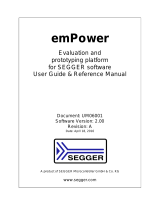
2.2 Current Consumption
The table below summarizes the data sheet current consumption of the various components on the board. The operating current of the
board greatly depends on the application. The number of enabled sensors, how often they are sampled, and how often the radio is
transmitting or receiving are examples of factors that influence the operating current. In many cases the given conditions differ from the
operating conditions on the xG27 Dev Kit, but the table can still be used as an indication of how much each feature contributes to the
total current consumption. More details can be found in the specific data sheet for each device.
Table 2.2. Current Consumption
Parameter Symbol Condition Typ Unit
EFR32BG27 Current Con-
sumption1
IEFR32 MCU current consumption in EM0 mode with all peripher-
als disabled (dc-dc converter at 3.0 V input and 1.8 V out-
put, VSCALE1, 38.4 MHz crystal, CPU running Prime from
flash at 25 ˚C)
30 µA/MHz
EM4, no BURTC, no LF oscillator 0.18 µA
Radio system current consumption in receive mode, active
packet reception (dc-dc converter at 3.0 V input and 1.8 V
output, MCU in EM1 and all MCU peripherals disabled,
HCLK = 38.4 MHz, 1Mbit/s, 2GFSK, f = 2.4 GHz,
VSCALE1 at 25 ˚C)
4 mA
Radio system current consumption in transmit mode (dc-
dc converter at 3.0 V input and 1.8 V output, MCU in EM1
and all MCU peripherals disabled, HCLK = 38.4 MHz, f =
2.4 GHz, CW, 8 dBm output power, VSCALE1 at 25 ˚C)
11.5 mA
Ambient Light Sensor Cur-
rent Consumption 2
IVEML6035 Shutdown at 1.8 V 0.5 µA
Operation mode at 1.8 V (ALS only) 170 µA
RH/Temp Sensor Current
Consumption3
ISi7021 Standby, -40 to +85˚C 0.06 µA
RH conversion in progress 150 µA
Temperature conversion in progress 90 µA
Peak IDD during I2C operations 3.5 mA
Hall Effect Magnetic Sensor
Current Consumption 4
IDD Sleep mode at 3.3 V 50 nA
Average current for periodic activation at 3.3 V, sleep tim-
er enabled, 200 msec sleep time
0.4 µA
Conversion in progress at 3.3 V 5 mA
Microphone Current Con-
sumption5
IMIC Sleep mode current (Fclock = 0 Hz, VDD = 3.6 V) 26 µA
Supply current in performance mode (VDD = 3.6 V, Fclock
= 2.4 MHz)
700 µA
IMU Current Consumption6IIMU Full-chip sleep mode at 1.8 V supply 6 µA
Gyroscope only, 100 Hz update rate at 1.8 V supply 1.6 mA
Accelerometer only, 100 Hz update rate at 1.8 V supply 57 µA
Gyroscope + Accelerometer, 100 Hz update rate at 1.8 V
supply
1.9 mA
Serial Flash Memory Cur-
rent Consumption 7
IFlash Deep power-down current in ultra-low-power mode at 1.8
V
0.007 µA
Standby current in ultra-low-power mode at 1.8 V 5 µA
Write status register current in ultra-low-power mode at
1.8 V
3.1 mA
UG554: xG27 Dev Kit User's Guide
Specifications
silabs.com | Building a more connected world. Rev. 1.0 | 7























